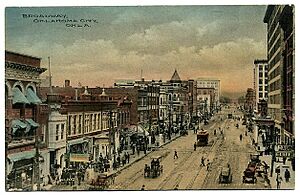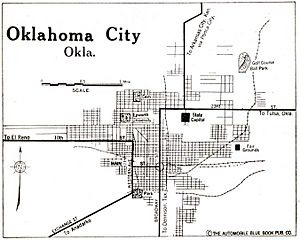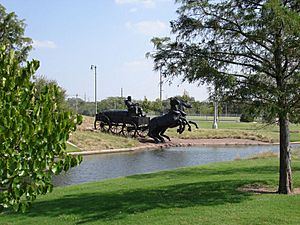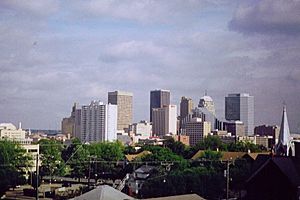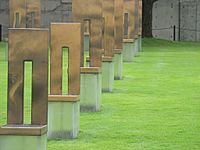History of Oklahoma City facts for kids
The history of Oklahoma City tells the story of how the city of Oklahoma City grew from empty lands into a major city. It all started with the settlement of "unassigned lands" in the 1880s. The city then developed through Oklahoma becoming a state, World War I, and important events like the Oklahoma City bombing.
Contents
Before the City Was Built
Before the big Land Rush of 1889, the area where Oklahoma City now stands was called the “Unassigned Lands”. These lands were in central Oklahoma, just north of the Chickasaw Nation. A journalist named Elias C. Boudinot first used the term "Unassigned Lands" in 1879. He thought these lands should be open for white settlers to claim.
This central Oklahoma territory was not home to any of the Native American tribes who had been moved there by the Indian Removal Act of 1830. It was surrounded by other Native American territories. To the north was the Cherokee Nation. To the east were the Potawatomi, Shawnee, Sac and Fox, Pawnee, and Iowa reservations. The Chickasaw Nation was to the south, and the Cheyenne Arapaho settlement was to the west.
Five rivers crossed these lands, including the Canadian and North Canadian rivers. This made the land great for both raising cattle and growing crops. Many white settlers wanted to claim these inexpensive lands.
Before the official opening of these lands, a group called the Boomer Movement tried to settle there illegally. From 1879 to 1888, leaders like David L. Payne and William Couch led raids and tried to claim spots in the unassigned lands. They even started a town called Ewing in 1880, which is now Oklahoma City. However, U.S. troops often removed them. Despite this, the Boomers kept trying to settle illegally until the Land Run of 1889.
Early Years: 1889-1917
Oklahoma City officially opened for settlement on April 22, 1889, during the Land Run. The city grew incredibly fast, almost overnight! At first, Oklahoma City had a temporary government because the federal government didn't expect such quick growth. On May 2, 1890, the Organic Act was passed. This act made laws from Nebraska apply to the new Oklahoma Territories until local governments could create their own. Oklahoma City became the official county seat for one of Oklahoma's counties, with Guthrie, Oklahoma as the capital.
The first temporary mayor of Oklahoma City was William L. Couch, a former Boomer leader. He resigned in 1889, and Sidney Clarke took over. Clarke was provisional mayor until an election on November 27, 1889, when Andrew J. Beale became mayor. The first non-temporary mayor, William J. Gault, was elected in 1890.
A rivalry grew between Oklahoma City and Guthrie, the state capital. Important Oklahoma politicians, like Governor Charles N. Haskell, wanted Oklahoma City to be the capital instead. This rivalry ended on June 11, 1910, when Oklahoma City won by popular vote. There were rumors that someone from Oklahoma City secretly moved the state seal from Guthrie to make sure the capital moved. Oklahoma City has been Oklahoma's capital ever since, with the Oklahoma State Capitol building finished in 1917.
City Builders
Important leaders helped shape Oklahoma City in its early years. These included John Shartel, Anton H. Classen, James W. Maney, and Henry Overholser. They improved the city's buildings, public transportation, entertainment, and railroad system. They laid the groundwork for the city's future growth.
Henry Overholser was an early settler who loved public entertainment. He built the Grand Avenue Hotel in 1889 and the Overholser Opera House and Theater in 1890. He also helped buy land for the Oklahoma State Fair in 1906.
Anton Classen was appointed by President William McKinley to a land office job in 1897. He focused on making the city more beautiful and improving its buildings. He became president of the Oklahoma City Building and Loan Association and the Oklahoma City Commercial Club in 1899.
Classen worked closely with John Shartel to add many new housing areas as the population grew. They also helped pave city streets and promoted Oklahoma City for events. In 1902, Classen and Shartel created the Metropolitan Railroad Company, which built a good public transport system for downtown Oklahoma City. Classen also helped start Epworth University (now Oklahoma City University) in 1904.
John Shartel also bought land that became known as the Florence Addition. He worked with Classen in various city organizations. After Classen's death in 1922, Shartel became president of the Oklahoma City Building and Loan Association and the Oklahoma City Commercial Club.
James W. Maney focused on building railroads in Oklahoma City. By 1900, he was known as "the largest railroad contractor in Oklahoma." He built the second railroad into Oklahoma City when the territory opened in 1889. Maney's home, the historic Maney House, is now a bed and breakfast.
Before World War II
Oklahoma City kept growing steadily. Then, on December 4, 1928, oil was discovered in the city! Oil wells appeared everywhere, even on the lawn of the capitol building. This sudden rush of oil money quickly made the city grow even faster.
While some people became rich from the oil boom, most Americans and Oklahomans struggled during the Great Depression. By 1935, many people who had lost their jobs or moved from farms built a huge shanty town (also called a "Hooverville") along the North Canadian River. The river often flooded, causing sickness and hardship.
As part of the "New Deal" programs, the Works Progress Administration and Civilian Conservation Corps lowered the river's level to prevent flooding. They also built some of the country's first public housing.
In 1932, the city built a camp called Elm Grove, which offered better living conditions for those who paid a small fee or worked. However, this camp was closed in 1933 because officials worried it would attract more homeless people. A May Avenue Camp still existed in 1939.
After World War II
World War II and the growth of war industries helped the nation and Oklahoma City recover. After the war, Oklahoma City became a major center for the national Interstate Highway System. Tinker Air Force Base in Midwest City became the largest air depot in the country.
During the civil rights era, downtown Oklahoma City became important for civil rights protests. In 1958, history teacher Clara Luper and her students from Douglass High School led one of the first "sit-ins" in American history. They sat at a lunch counter in a downtown department store to protest segregation. When they succeeded, this protest method was used by activists across the country.
From February to July 1964, Oklahoma City experienced eight sonic booms every day. This was part of a test to see how loud supersonic aircraft would affect people and the economy. The experiment led to 15,400 damage claims. The problems from these tests partly led to the end of a project to build a supersonic transport aircraft seven years later.
City Challenges and Renewal
By the 1960s, Oklahoma City began to face challenges. Many people moved from the city center to the suburbs, and the downtown area became less lively. The oil beneath the city also started to run out, and property values dropped.
City leaders then started a program called "urban renewal." This program unfortunately ended up tearing down many old buildings, including parts of the theater district. The city had planned to build a huge shopping mall downtown called "The Galleria." But they ran out of money after only building the parking garage. This left downtown Oklahoma City with empty lots where beautiful old buildings once stood. The 1970s and 1980s were slow times for Oklahoma City, while its suburbs grew quickly. Not much was done to improve the inner city during this period, even during a late 1970s oil boom.
The 1990s
By 1992, Oklahoma City needed big changes. It was losing jobs and people to other cities. Mayor Ron Norick pushed for a huge plan to improve downtown called the Metropolitan Area Projects Plan, or MAPS.
MAPS proposed a five-year, one-cent sales tax to pay for new projects. These included a new ballpark, a canal through Bricktown, a new central library, a large indoor arena, and improvements to the fairgrounds and civic center. It also planned for dams on the North Canadian River to make it more attractive for boats. Even though people were still disappointed by the earlier "urban renewal" failures, they voted to approve MAPS. This plan eventually raised over 1 billion dollars for city improvements and brought life back to the city center.
Oklahoma City Bombing
During this time of hope and change, a terrible event happened. On April 19, 1995, a truck filled with explosives blew up outside the Alfred P. Murrah Federal Building in downtown Oklahoma City. The explosion killed 168 people, including 19 children, and injured more than 680. Many nearby buildings were also damaged or destroyed.
Until the September 11 attacks, this was the largest terrorist attack on American soil. It remains the largest domestic terrorist attack in American history.
The site is now home to the Oklahoma City National Memorial. This memorial was designed by Oklahoma City architects Hans and Torrey Butzer, and Sven Berg. President Clinton dedicated it on April 19, 2000, exactly five years after the bombing. Oklahoma City has since rebuilt, and today, apart from the memorial, there is little sign of the bombing.
The Federal Bureau of Investigation (FBI) led a huge investigation into the bombing. It was the largest criminal case in American history at the time.
The 21st Century
As Oklahoma City moves through the 21st century, new changes continue to bring more people, jobs, and entertainment. In 2004, a new Dell call center brought over 250 jobs. In 2005, Oklahoma got its first major league basketball team, the New Orleans/Oklahoma City Hornets. Then, in 2008, the Oklahoma City Thunder became the city's permanent NBA team.
Many other companies are choosing Oklahoma City as their home, and the population is growing very quickly again. A new tall building, the Devon Energy Center, was finished in 2012. It has 52 stories and is 850 feet tall, adding to the downtown skyline.
Images for kids



